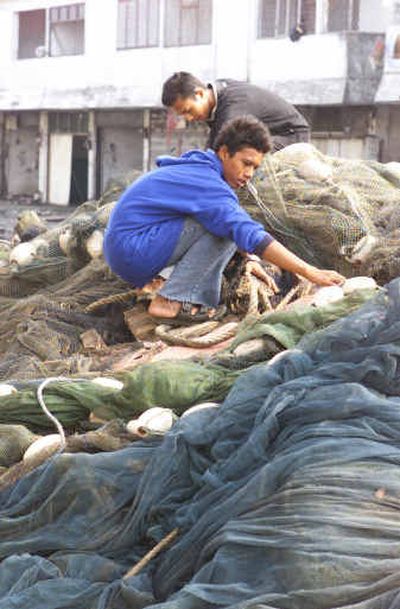Fears force diet staple off Asian menus

JAKARTA, Indonesia – Top hotels in several Asian capitals have stopped ordering sea bass and sole from waters off their tsunami-ravaged coastlines to ease diners’ concerns about fish feasting on corpses.
Some have turned to suppliers in Australia, while others are buying fish from Indonesian islands off the Pacific Ocean that were untouched by disaster – dealing another blow to fishermen whose livelihoods were shattered by the giant waves.
Health officials say fears of fish are unwarranted and insist there is no evidence of a risk posed by eating fish from the Indian Ocean, where at least 160,000 people died in Asia and Africa. But, in a region that suffered through bird flu and other recent food scares, several top eateries and their suppliers are unwilling to take chances.
Markus Schneider, a manager at Jakarta’s Mandarin Oriental, said the hotel’s first reaction to the Dec. 26 disaster was to collect donations for victims. Then, the focus turned to seafood dishes at the hotel’s three restaurants.
“We went straight to our suppliers to make sure their supplies didn’t come from Sumatra,” he said. Many did, including the shrimp for an Italian risotto, the antipasti’s calamari and the sea bass filets served over sauteed greens.
Tens of thousands died on Sumatra island after the magnitude 9 temblor and tsunami that followed.
Some of the hotel’s fish was already imported, but all orders that had come from Indonesia were switched to Australia. That increases costs by about 15 percent, a figure that doesn’t worry hotels that cater to business travelers and tourists.
“We didn’t want people to be concerned. There’s nothing worse than a sick customer,” said Schneider. The hotel’s branch in Thailand’s capital, Bangkok, has taken similar precautions, he said.
International health agencies, including the World Health Organization and the Food and Agriculture Organization, say the fears are unfounded.
“The fish myth is making the rounds all over the place,” said Harsaran Pandey, a WHO spokeswoman. “The fears are not scientifically based.”
There is no evidence fish in tsunami-hit areas are feeding off corpses or that it would cause a health risk if they were, Pandey said. And Pandey said there also is no evidence of higher mercury levels or other toxins in the Indian Ocean since the tsunami, noting that most of what washed away were villages and beach front properties rather than industries.
Villagers across tsunami-hit coastlines in Sri Lanka, Thailand, Indonesia and elsewhere have reported losing their appetite for fish – sparking nutritional concerns that their diets would lack sufficient protein, Pandey said.
Fish is a staple in the tsunami-hit region – and even people who have lived off the sea their entire lives now are wary.
In the days after the disaster, fish mongers in Indonesia’s provincial capital, Banda Aceh, reported sales were poor as many who had seen the waves engulf loved ones worried about fish feeding off bodies.
Thai health officials have gone to great lengths to show a wary public they have nothing to fear. Officials have conducted regular tests on sea water and fish from affected areas. In the battered coastal province of Phang-Nga, health ministry officials cut open the bellies of tuna, sea bass and other fish caught in the Andaman Sea to show there were no human remains inside.
In Malaysia, the fish sellers’ association organized a free feast of the local catch last week, attracting hundreds of people.
Some 1,100 pounds of fish and prawns were fried and served during the feast in northern Penang state, where most of Malaysia’s 68 tsunami deaths occurred. Fish sales in Penang had plunged by about 50 percent after rumors that a human finger was found in a fish’s belly.